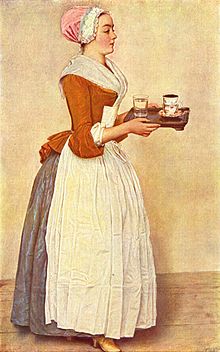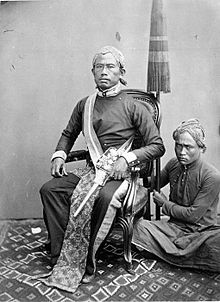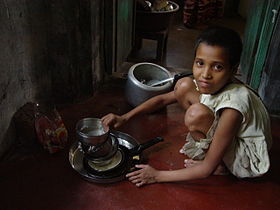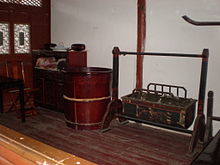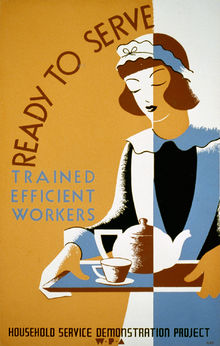- Domestic worker
-
 A Han Dynasty (202 BC - 220 AD) Chinese ceramic figurine of a lady servant making a respectful gesture with both hands in front holding an accordion
A Han Dynasty (202 BC - 220 AD) Chinese ceramic figurine of a lady servant making a respectful gesture with both hands in front holding an accordion
A domestic worker is a man, woman or child who works within the employer's household. Domestic workers perform a variety of household services for an individual or a family, from providing care for children and elderly dependents to cleaning and household maintenance, known as housekeeping. Responsibilities may also include cooking, doing laundry and ironing, food shopping and other household errands. Some domestic workers live within the household where they work.
The conditions faced by domestic workers have varied considerably throughout history and in the contemporary world. In the course of twentieth-century movements for labour rights, women's rights and immigrant rights, the conditions faced by domestic workers and the problems specific to their class of employment have come to the force. In 2011, the International Labour Organization adopted the Convention Concerning Decent Work for Domestic Workers which covers decent work conditions for domestic workers. Recent ILO estimates based on national surveys and/or censuses of 117 countries, place the number of domestic workers at around 53 million. But the ILO itself states that "experts say that due to the fact that this kind of work is often hidden and unregistered, the total number of domestic workers could be as high as 100 million". The ILO also states that 83% of domestic workers are women and many are migrant workers.
Servant is an older English term for "domestic worker", though not all servants worked inside the home.
Contents
History
Domestic service, or the employment of people for wages in their employer's residence, was sometimes simply called "service". It evolved into a hierarchical system in various countries at various times.
The United Kingdom's Master and Servant Act of 1823 was the first of its kind and influenced the creation of domestic service laws in other nations, although legislation tended to favour employers. However, before the passing of such Acts servants, and workers in general, had no protection in law. The only real advantage that domestic service provided was the provision of meals, accommodation, and sometimes clothes, in addition to a modest wage. Service was normally an apprentice system with room for advancement through the ranks.
In Britain this system peaked towards the close of the Victorian era, perhaps reaching its most complicated and rigidly structured state during the Edwardian period, which reflected the limited social mobility of the time. The equivalent in the United States was the Gilded Age.
Current situation around the world
In July 2011, at the annual International Labour Conference, held by the ILO, conference delegates adopted C189, the Convention on Domestic Workers (2011) by a vote of 396 to 16, with 63 abstentions. The Convention recognizes domestic workers as workers with the same rights as other workers. The Convention text can be found on the ILO website here.
Throughout the world, most domestic workers are from the same country in which they work.[citation needed] They may live at home, though they are usually "live-in" domestics, meaning they receive room and board as part of their salaries. Because of the large gap between urban and rural incomes, and the lack of employment opportunities in the countryside, even an ordinary middle class urban family can afford to employ a full-time live-in servant. The majority of domestic workers in China, Mexico, India, and other populous developing countries, are people from the rural areas who are employed by urban families.
'In Guatemala, it is estimated that eight percent of all women work as domestic workers. They hardly have any legal protection. According to Guatemalan labour law, domestic work is “subject neither to a working time statute nor to regulations on the maximum number of working hours in a day”. Legally, domestic helpers are only entitled to ten hours of free time in 24 hours, and one day off per week. But very often, these minimal employment laws are disregarded, and so are basic civil liberties.' [1]
In Brazil, domestic workers must be hired under a registered contract and have most of the rights of any other workers, which includes a minimum wage, remunerated vacations and a remunerated weekly day off. It is not uncommon, however, to hire servants without registering them. Since servants come almost always from the lower, uneducated classes, they are sometimes ignorant of their rights, especially in the rural zone. Nevertheless, domestics employed without a proper contract sometimes sue their employers to get compensation from abuses.[citation needed]
In the United States, domestic workers are excluded from many of the legal protections afforded to other classes of worker, including the provisions of the National Labour Relations Act.[2] Traditionally domestic workers have mostly been women and are likely to be immigrants.[3]
Child domestic workers
Child maid servant in India. Child domestic workers are common in India, with the children often being sent by their parents to earn extra money, although it is banned by the government.
The use of children as domestic servants continues to be common in parts of the world, such as Latin America or parts of Asia. Such children are very vulnerable to exploitation: often they are not allowed to take breaks or are required to work long hours; many suffer from a lack of access to education, which can contribute to social isolation and a lack of future opportunity. UNICEF considers domestic work to be among the lowest status, and reports that most child domestic workers are live-in workers and are under the round-the-clock control of their employers. [4] Some estimates suggest that among girls, domestic work is the most common form of employment.[5] Child domestic work is common in countries such as Bangladesh or Pakistan.[6] [7]It has been estimated that globally, at least 10 million children work in domestic labor jobs.[8]
Domestic work and international migration
Many countries import domestic workers from abroad, usually poorer countries, through recruitment agencies and brokers because their own nationals are no longer obliged or inclined to do domestic work. This includes most Middle Eastern countries, Hong Kong, Singapore, Malaysia and Taiwan. For most of these countries, the number of domestic workers run into the hundreds of thousands. There are at least one million domestic workers in Saudi Arabia.
Major sources of domestic workers include the Philippines, Thailand, Indonesia, India, Bangladesh, Pakistan, Sri Lanka, and Ethiopia. Taiwan also imports domestic workers from Vietnam and Mongolia. Organizations such as Kalayaan support the growing number of these migrant domestic workers.
Uniform
Employers may require their domestic workers to wear a uniform, livery or other "domestic workers' clothes" when in their employers' residence. The uniform is usually simple, and was even in the 19th century and 20th centuries. Female servants wore long, plain, dark-coloured dresses or black skirts with white belts and white blouses, and black shoes, and male servants and butlers would wear something from a simple suit, or a white dress shirt, often with tie, and knickers. In traditional portrayals, the attire of domestic workers especially was typically more formal and conservative than that of those whom they serve. For example, in films of the early 20th century, a butler might appear in a tailcoat, while male family members and guests appeared in lounge suits or sports jackets and trousers depending on the occasion. In later portrayals, the employer and guests might wear casual slacks or even jeans, while a male domestic worker wore a jacket and tie or a white dress shirt with black pants, necktie or bowtie, maybe even waistcoat, or a female domestic worker either a blouse and skirt (or trousers) or a dress.
Accommodation
Many domestic workers are live-in domestics. Though they often have their own quarters, their accommodations are not usually as comfortable as those reserved for the family members. In some cases, they sleep in the kitchen or small rooms, such as a box room, sometimes located in the basement or attic.
Notable domestic workers
Real people
- Céleste Albaret, housekeeper of Marcel Proust
- Gladys Aylward, maid, afterwards missionary
- Alice Ayres
- Sarah Balabagan
- Fonzworth Bentley
- Paul Burrell, butler to Diana, Princess of Wales
- Flor Contemplacion
- Elizabeth Cotten
- Hannah Cullwick
- Lisette Denison Forth, maid and philanthropist
- Caroline Herschel, astronomer (worked as a domestic servant in her father's household until his death)
- Paul Hogan
- Dora Lee Jones
- Margaret Maher, maid to Emily Dickinson
- Papin sisters
- Lillian Rogers Parks
- Rose Porteous
- Casimira Rodríguez
- Margaret Rogers
Fictional characters
- Hugo Barrett, the valet in the film The Servant
- Mr. Belvedere from the sitcom Mr. Belvedere
- Benson from the sitcom Soap and the spin-off show Benson
- Berta, the Harpers' housekeeper on Two and a Half Men
- Ellen and Clara Brill from Mary Poppins
- Geoffrey from the sitcom The Fresh Prince of Bel-Air
- Celestine, the chambermaid in Octave Mirbeau's novel The Diary of a Chambermaid and in the two films adapted from it
- Crichton
- Mrs. Doyle, housekeeper for the three priests in Father Ted
- Jane Eyre, heroine of the novel Jane Eyre, a governess
- Mr. French from the sitcom Family Affair.
- Mrs. Grose, the housekeeper in The Turn of the Screw by Henry James
- Hirsch, Mrs. Carlson's butler in the sitcom WKRP in Cincinnati
- Mr. Hudson from the TV serial Upstairs, Downstairs
- Jeeves a valet from P. G. Wodehouse's stories.
- Miss Jessel, the governess in The Turn of the Screw by Henry James
- Florence Johnston, from The Jeffersons
- Joseph, Elliott's manservant in The Razor's Edge
- Janet MacPherson, the housekeeper in Dr. Finlay's Casebook
- Mammy, the maid in Gone with the Wind (film)|Gone with the Wind]]
- Niles, the Butler from the sitcom The Nanny.
- Sancho Panza, from Don Quixote
- Alfred Pennyworth, butler to Batman
- Planchet, from The Three Musketeers
- Rosie the Robot from The Jetsons
- Rosario Salazar, maid to Karen Walker in Will and Grace
- Stevens in the 1989 novel The Remains of the Day
- Alf Stokes, butler, from the sitcom You Rang, M'lord?
Different domestic worker jobs
- Au pair, foreign-national domestic assistant working for, and living as part of, a host family
- Between maid, an in-between maid; her duties being half in the reception rooms and half in the kitchen
- Boot boy, a young male servant, employed mostly to perform footwear maintenance and minor auxiliary tasks
- Butler, a senior employee, almost invariably a man, whose duties traditionally include overseeing the wine cellar, the silverware, and some oversight of the other servants
- Charlady or char, a female house cleaner servant
- Chauffeur, a personal driver
- Cook, either a cook who works alone or the head of a team of cooks
- Dog walker
- Footman
- Gardener
- Governess, a woman teacher for the children
- Groundskeeper
- Handyman (household repairs)
- Horse trainer
- Housemaid
- Housekeeper, a senior employee, usually female
- Knave
- Lackey
- Laundress
- Maid
- Masseur/Masseuse
- Nanny (once known as a nurse), a woman taking care of infants and children
- Nursemaid
- Personal shopper
- Personal trainer (fitness, swimming, sports)
- Pool person
- Scullery maid
- Secretary (social or corresponding)
- Security guard
- Stable boy
- Valet or "gentleman's gentleman", responsible for the master's wardrobe and assisting him in dressing, etc. In the armed forces some officers have a soldier (in the British army called a batman) for such duties
- Wet nurse, provides suckling for infants if mothers do not wish to do so themselves
See also
- Convention on domestic workers
- Female servants in 18th century England
- Foreign domestic helpers in Hong Kong
- Household chore
- Isabella Beeton ("Mrs Beeton") and The Book of Household Management
- Maid
- National Union of Domestic Employees
- Saint Zita, the patron saint of domestic servants
- Similar work performed not within the home but, for example, on cruise lines
- Fiction
- The Diary of a Chambermaid, a novel by Octave Mirbeau
- The Man Booker prize winning novel The Remains of the Day
- Upstairs, Downstairs, a British television series set in London
- Downton Abbey, a British television series set in a large country house
References
- ^ Verfürth, Eva-Maria (N.D.). "Hard work new opportunities". D+C Development and Cooperation No. 09 2009. http://www.inwent.org/ez/articles/156165/index.en.shtml. Retrieved 2009-01-10.
- ^ See the UN Human Rights Committee's report, "Domestic Workers' Rights in the United States."
- ^ Graff, Daniel A. (N.D.). "Domestic Work and Workers". The Electronic Encyclopedia of Chicago. http://www.encyclopedia.chicagohistory.org/pages/386.html. Retrieved 2009-08-31.
- ^ http://paa2009.princeton.edu/download.aspx?submissionId=90836
- ^ http://www.antislavery.org/includes/documents/cm_docs/2009/a/advocacyhandbookeng.pdf
- ^ .http://www.cprspd.org/Publications/CHILD%20DOMESTIC%20LABOUR%20IN%20PAKISTAN-final-3.pdf
- ^ http://www.allacademic.com/meta/p_mla_apa_research_citation/0/9/9/7/5/p99757_index.html
- ^ http://www.allacademic.com/meta/p_mla_apa_research_citation/0/9/9/7/5/p99757_index.html
Further reading
- The Duties of Servants; by a member of the aristocracy, author of 'Manners and Rules of Good Society'. London: F. Warne & Co., 1894
- A Few Rules for the Manners of Servants in Good Families. Ladies' Sanitary Association, 1901
- The Servants' Practical Guide: a handbook of duties and rules; by the author of 'Manners and Tone of Good Society'. London: Frederick Warne & Co., [1880]
- The Management of Servants: a practical guide to the routine of domestic service; by the author of “Manners and Tone of Good Society.” (the same work under a different title)
- Dawes, Frank (1973) Not in Front of the Servants: domestic service in England 1850-1939. London: Wayland ISBN 0853402876
- Evans, Siân (2011) Life below Stairs in the Victorian and Edwardian Country House. National Trust Books
- --do.--"Yells, Bells and Smells ... from royal visits ... to the case of the cook and the freezer", in: National Trust Magazine; Autumn 2011, pp. 70-73
External links
- International Domestic Workers Network
- List of digitized books on domestic workers in German, English, and other languages at de.wikisource
- ILO resources on domestic workers:
- Amnesty International paper on the abuse of domestic workers in the Middle East
- A Global Justice Center paper about domestic workers worldwide
- An international campaign for domestic workers' labour rights
- Human Rights Watch article about migrant domestic workers
Categories:- Domestic workers
- Cleaning and maintenance occupations
Wikimedia Foundation. 2010.

